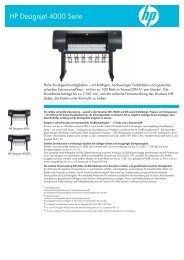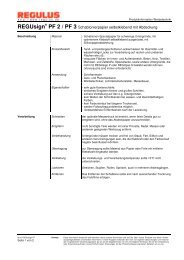STOCHASTIC HALFTONE SCREENING
STOCHASTIC HALFTONE SCREENING
STOCHASTIC HALFTONE SCREENING
Create successful ePaper yourself
Turn your PDF publications into a flip-book with our unique Google optimized e-Paper software.
C G T T E C H N I C A L P U B L I C A T I O N S<br />
Advanced FM algorithms can have<br />
multiple sized spots. If all of the pixels are<br />
the same size, the halftone is said to be<br />
“first order.” If there are two different<br />
sizes, the halftone is “second order.” The<br />
ability to have two different sized pixels<br />
aids in smoothness of the tonal reproduction.<br />
Random intermixing of differing dot<br />
sizes helps to break up the apparent<br />
“graininess” of the rendered surface.<br />
Currently most FM algorithms are first<br />
order in nature.<br />
Resolution and detail<br />
Conventional halftones are generated<br />
from the center of the halftone cell outward.<br />
This is known as a “dot centered<br />
cluster array.” With Postscript®, the<br />
smallest dot that can be generated is .4%,<br />
and tonal steps increase in multiples of<br />
.4%. Since the dots are generated outward<br />
from the center of the cell, there is a<br />
physical limitation to the level of detail<br />
that can be rendered at any given line<br />
count. This detail is governed by the dot<br />
density which increases geometrically as<br />
line count increases. For instance the dot<br />
density of a 65 line halftone is 65 x 65 or<br />
4225 dots per square inch. An 85 line<br />
halftone has a dot density of 85 2 , or 7225<br />
dots per square inch. The ability to resolve<br />
detail is further limited by the fact that<br />
halftone dots are generated on predetermined<br />
centers.<br />
Stochastic halftones are limited only by<br />
the size of the pixel that is defined. With<br />
current lithographic FM software this pixel<br />
size happens to correspond to the laser<br />
spot size. This is usually 7, 14, or 20<br />
microns in diameter. A 20 micron dot is<br />
slightly smaller than .001" in diameter<br />
(.001" = 25.4 microns). With lithographic<br />
printing the dot size is limited by the<br />
ability of a aluminum litho plate to image<br />
and physically hold these very small dots.<br />
As far as screen printing is concerned, this<br />
limitation is not one of ability of the<br />
emulsion to resolve the detail. The problem<br />
comes from the mesh threads blocking<br />
the halftone dot. With typical 390 mesh,<br />
the thread diameter can range between 27<br />
to 34 microns in diameter. We can easily<br />
see that there is the possibility for total<br />
halftone blockage, or total halftone<br />
fidelity, depending on where the halftone<br />
hits the thread of the mesh. The smaller<br />
the halftone dot becomes, the greater the<br />
chances of thread interference. This is the<br />
main reason it is so difficult to print high<br />
line counts (over 120) with conventional<br />
halftones.<br />
The key to understanding the advantages<br />
of detail reproduction with FM<br />
halftones is that we must compare them to<br />
conventional halftones for some correlation.<br />
FM halftones are of one size only.<br />
We simply define the size of the pixel and<br />
the software does the rest. Much smaller<br />
dots are printable without thread interference<br />
because the pixels are not locked to<br />
predetermined grid based centers. The<br />
tendency is for smaller FM dots to follow<br />
the detail. If you are familiar with the art<br />
technique known as pointillism or stippling,<br />
you can easily visualize how the FM<br />
dot concentrates along the edges of the<br />
detail in the image. Depending on the<br />
resolution of the dot that is selected, the<br />
detail carrying capacity of FM compared<br />
to conventional can be three to ten times<br />
greater!<br />
Reduction in moiré<br />
Moiré is probably the number one<br />
problem of screen printed halftones. There<br />
are many causes of moiré, and many of<br />
them are unique to the screen printing<br />
process. Moiré can be controlled on a<br />
limited basis when using conventional<br />
halftone reproduction. The success is<br />
greatest at the lower line counts (below<br />
100 lines per inch). Even experienced<br />
halftone printers are faced with surprise<br />
moiré. This is what makes it so frustrating.<br />
TECH LIBRARY<br />
ONLINE<br />
TECHNICAL<br />
SUPPORT<br />
©1994 Coudray Graphic Technologies :: 805.541.1521 <strong>STOCHASTIC</strong> <strong>HALFTONE</strong> <strong>SCREENING</strong><br />
4
















